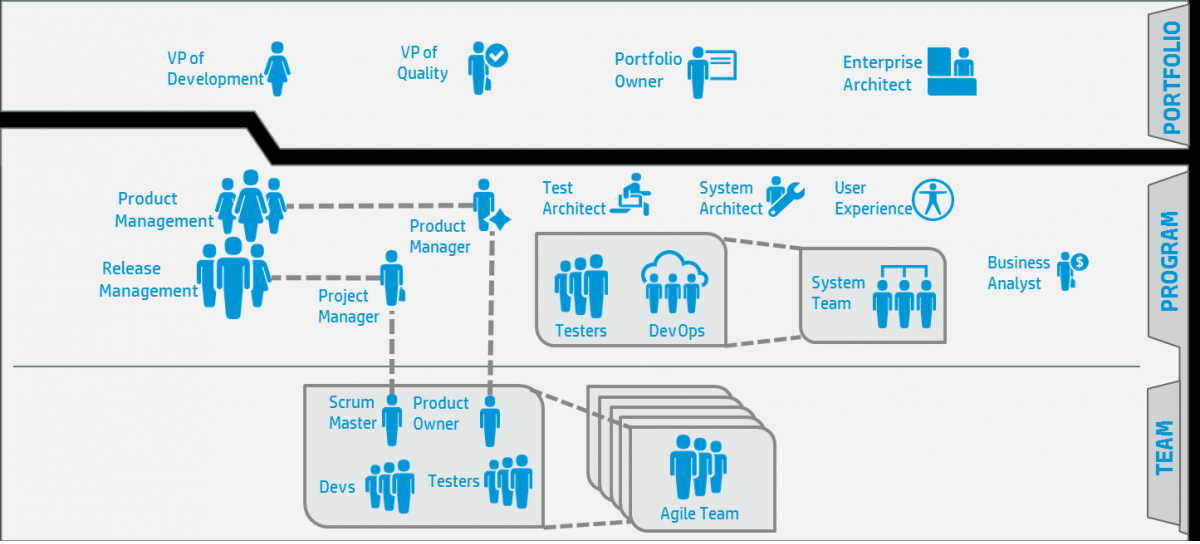Agile At Scale
What is Agile at Scale?
Agile at Scale refers to extending Agile principles beyond individual teams to encompass entire organizations. It's about coordinating multiple Agile teams to work harmoniously towards common goals, ensuring alignment, and delivering value efficiently.
Example: Imagine a company like SLSI Corp, which is building a large banking software system. One team is working on the login module, another team is building transaction services, and a third team handles reporting. Instead of each team doing its own thing, Agile at Scale ensures all teams are aligned, collaborate regularly, and deliver integrated results — just like parts of a machine working in sync.
Key Points:
- It's about scaling Agile practices beyond small teams.
- It ensures coordination and collaboration between multiple teams.
- It helps deliver complex, enterprise-level products efficiently.

What are the Principles of Agile at Scale?
Agile at Scale follows some core guiding principles to ensure success across a larger landscape:
- Customer Focused Delivery - Always aim to deliver value that the end-user truly needs. Example: Every sprint includes a demo to a Product Owner to confirm that the product is heading in the right direction.
- Transparency and Alignment - Everyone in the organization should know what others are working on. Example: All teams use a shared board where their tasks, blockers, and sprint goals are visible.
- Cross-functional Collaboration - Teams should not work in isolation. Example: Developers, testers, and business analysts from different teams hold a Scrum of Scrums meeting daily to stay aligned.
Process of Agile at Scale
Let’s simplify this into 5 practical steps:
- Form Cross-Functional Teams - Combine developers, testers, and analysts into small Agile teams. Each team focuses on a particular feature or service.
- Implement Agile Frameworks - Use scaling frameworks like SAFe (Scaled Agile Framework), Scrum@Scale, or LeSS (Large Scale Scrum). These give structure to the scaled environment.
- Align Goals Across Teams - Create shared goals, OKRs (Objectives & Key Results), and program-level backlogs. Example: All teams work toward releasing a new mobile banking app by Q2.
- Synchronize Iterations - All teams work in synchronized sprints, so integration happens smoothly. Teams meet regularly (Scrum of Scrums) to sync up.
- Regular Reviews and Retrospectives - After each sprint, conduct reviews not just at team level but across teams. Focus on feedback, improvement, and risk mitigation.
What is Scaling in Agile?
Scaling is the process of adapting Agile principles to larger teams or multiple teams working on the same product or program.
Example: SLSI Corp starts with one Agile team. When the project grows, 10 more teams join. To avoid confusion, SLSI Corp adopts the SAFe framework and uses an Agile Release Train to coordinate the work across teams.
Scaling Tools:
- SAFe – for enterprise-scale coordination.
- Scrum of Scrums – to synchronize teams.
- ART (Agile Release Train) – to deliver integrated product increments on a fixed schedule.
Challenges Faced During Agile Scaling Process
When companies try to scale Agile, they often face these common hurdles:
- Communication Gaps - As teams multiply, it's hard to keep everyone informed. Example: One team changes an API, but forgets to tell another team, breaking the integration.
- Resistance to Change - Traditional departments may resist Agile because they’re used to top-down command structures. Example: The finance or HR team might not like the transparency and constant change Agile demands.
- Lack of Training - Teams struggle without proper training in scaled Agile frameworks. Example: If team leads aren’t trained in SAFe roles, coordination may break down.
- Tooling and Integration Problems - Coordinating code from different teams can lead to integration nightmares. Success: Use CI/CD tools and automated testing pipelines to ensure smooth integration.
